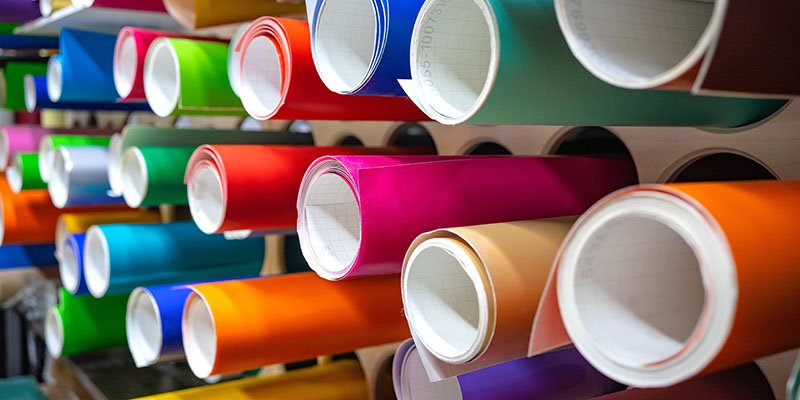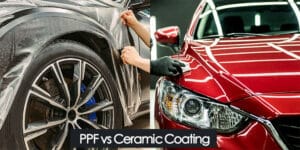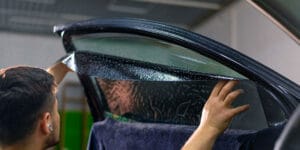When it comes to safeguarding a vehicle’s exterior, car owners are often faced with the decision between Paint Protection Film (PPF) and vinyl wrap. PPF is a clear, thick, and durable film designed primarily to protect paint from scratches, stone chips, and contaminants. It provides a virtually invisible shield that preserves the paint’s original luster and can significantly reduce the potential for wear and tear over time. Typically, PPF has a longer lifespan, offering protection for up to ten years before it may require replacement.
On the other hand, vinyl wrap serves a dual purpose: it not only offers a moderate level of protection against minor abrasions but is chiefly utilized for aesthetic transformations. Available in a multitude of colors and finishes, including matte and gloss, vinyl wrap allows vehicle owners to customize their car’s appearance without a permanent commitment. The installation of a vinyl wrap is typically less complex than that of PPF, which is a factor in its lower cost.
Installation quality is paramount for both PPF and vinyl wraps, as it can greatly influence durability and overall effectiveness. Professional installation ensures proper application, which can prevent peeling, bubbling, and early wear. Car owners must weigh the factors of paint protection, appearance enhancement, durability, and cost when deciding between PPF and vinyl wrap for their vehicle’s care.
Comparing Materials and Protection Qualities
When considering car exterior protection, materials matter. This section analyzes the composition, durability, and protective attributes of Paint Protection Film (PPF) and Vinyl Wrap, alongside their aesthetic potential.
Material Composition and Durability
Paint Protection Film (PPF) typically consists of thermoplastic urethane, a durable and flexible material. It is transparent, preserving the original look of the vehicle’s paint while offering self-healing properties for light scratches. PPF films usually vary in thickness from 5 to 10 mm, contributing to their significant protection against the likes of stone chips and road debris.
In contrast, Vinyl Wrap is predominantly a PVC-based material that excels in aesthetics and customization. While it is thinner than PPF, ranging between 2 to 3 mm, vinyl wraps still provide a layer of protection that can shield against minor scratches and paint imperfections. Vinyl’s flexible nature allows for a variety of colors and finishes, including glossy, matte, and textured effects, as well as complex graphics and designs.
Resistance to Environmental Factors
PPF offers excellent resistance to environmental factors such as UV rays, rain, and chemical stains like bird droppings or tree sap. This capability helps prevent fading and maintains the car’s original look over time.
Vinyl wraps also provide some degree of protection from the sun and chemical hazards, although they are generally less effective compared to PPF in terms of long-term durability against heavy abrasion from road debris.
Aesthetics and Customization Potential
PPF is invisible once applied, ensuring that the original paintwork remains the highlight. It mainly comes in a transparent finish, which means it doesn’t alter the car’s color or aesthetics but can add a glossy sheen to the existing paint.
Conversely, vinyl wraps deliver endless customization opportunities. They are available in a broad range of colors, finishes, and designs. A car can sport a new appearance frequently, making vinyl a popular choice for those aiming to personalize their vehicle or advertise a business with eye-catching graphics.
Installation, Maintenance, and Cost Considerations
When choosing between Paint Protection Film (PPF) and Vinyl Wrap, one should consider the intricacies of installation, the expected longevity of the product, and the financial investment required. These factors play a pivotal role in determining the value derived from each protection solution.
Installation Process and Professional Requirements
Paint Protection Film (PPF) installation is a meticulous process that often involves a professional installer due to the precision required. High-quality PPF is typically made of a thick, durable material that adheres to a vehicle’s contours and offers a self-healing capability for light scratches. This process is comprehensive and may include paint correction prior to the film application. In contrast, vinyl wrap can be more forgiving and is frequently offered as a DIY package, though professional installation is recommended for a transformative result. Both types of films require a clean installation environment to prevent contaminants under the film.
- PPF Installation Steps:
- Cleaning and paint correction
- Cutting the PPF to size
- Application with a squeegee to remove bubbles
- Vinyl Wrap Installation Steps:
- Cleaning the vehicle surface
- Measuring and cutting the wrap
- Applying and smoothing out the wrap
Maintenance and Longevity of Protection
Maintenance of PPF and vinyl wraps varies due to their material composition. PPF is generally constructed to repel dirt and water, requiring less frequent cleaning and offering superior protection from environmental elements like bird droppings and UV radiation. The lifespan of PPF can range from several years to the lifetime of the vehicle, bolstering its durability. Vinyl wraps are less resilient in the long term, typically lasting between six months to two years and may demand more maintenance and can be more prone to fading or peeling, reflecting their shorter lifespan when compared to PPF.
- PPF Longevity: Up to 10 years or more
- Vinyl Wrap Longevity: 6 months to 2 years
Analyzing the Financial Implications
The cost of PPF and vinyl wrap varies widely based on the vehicle’s size, the coverage level, and the brands chosen. PPF is generally more expensive with prices ranging from about $600 to $7,500, mostly due to material costs and the complexity of installation. On the other hand, vinyl wraps are more budget-friendly, with a cost range of approximately $350 to $5,500. It’s imperative to retrieve a free quote from professional installers due to fluctuations in pricing. Beyond the initial cost, one must consider the potential savings in maintenance and paint correction, as well as the impact on the vehicle’s resale value due to the protective layer offered by PPF.
- PPF Cost Range: $600 – $7,500
- Vinyl Wrap Cost Range: $350 – $5,500
The choice between PPF and vinyl wraps depends heavily on the user’s objectives, whether it be longevity and protection or aesthetic customization on a budget.
Frequently Asked Questions
Selecting the right type of protection for a vehicle is crucial, and two popular choices are Paint Protection Film (PPF) and vinyl wraps. Each offers different benefits and costs. Vehicle owners often weigh these options based on durability, aesthetics, protection, lifespan, combined usage, and impact on vehicle resale value.
What are the cost differences between PPF and vinyl wraps?
PPF is generally pricier, with costs ranging from $600 to $7,500. In contrast, vinyl wraps are more budget-friendly, typically costing between $350 and $5,500.
Which is more durable, PPF or vinyl wrap?
PPF is more durable against impacts and scratches, having self-healing properties that repair with heat application. However, vinyl wraps, while durable, do not offer the same level of protective features.
What are the pros and cons of PPF versus vinyl wrap for vehicle protection?
PPF pros include superior protection against chips, scratches, and UV light, along with hydrophobic and self-healing traits. Cons are the higher cost and less variety in appearance. Vinyl wrap pros focus on aesthetic customization and cost-effectiveness. Its cons include lower protection levels and a lack of self-healing properties.
What is the expected lifespan of PPF compared to vinyl wraps?
PPF can last between 5 and 10 years, whereas vinyl wraps typically last 4 to 5 years, depending on factors such as exposure to the elements and maintenance.
Can PPF and vinyl wrap be used together, or is one sufficient for car protection?
PPF and vinyl wraps can be used together; PPF for protection on high-impact areas and vinyl wrap for overall aesthetics. However, either can be sufficient depending on the owner’s protection and style preferences.
How do PPF and vinyl wraps impact the resale value of a car?
Both PPF and vinyl wraps can preserve paint quality, which may help maintain the vehicle’s resale value. PPF provides better protection, potentially leading to a higher resale value, but wraps that are well-maintained can also contribute positively.



